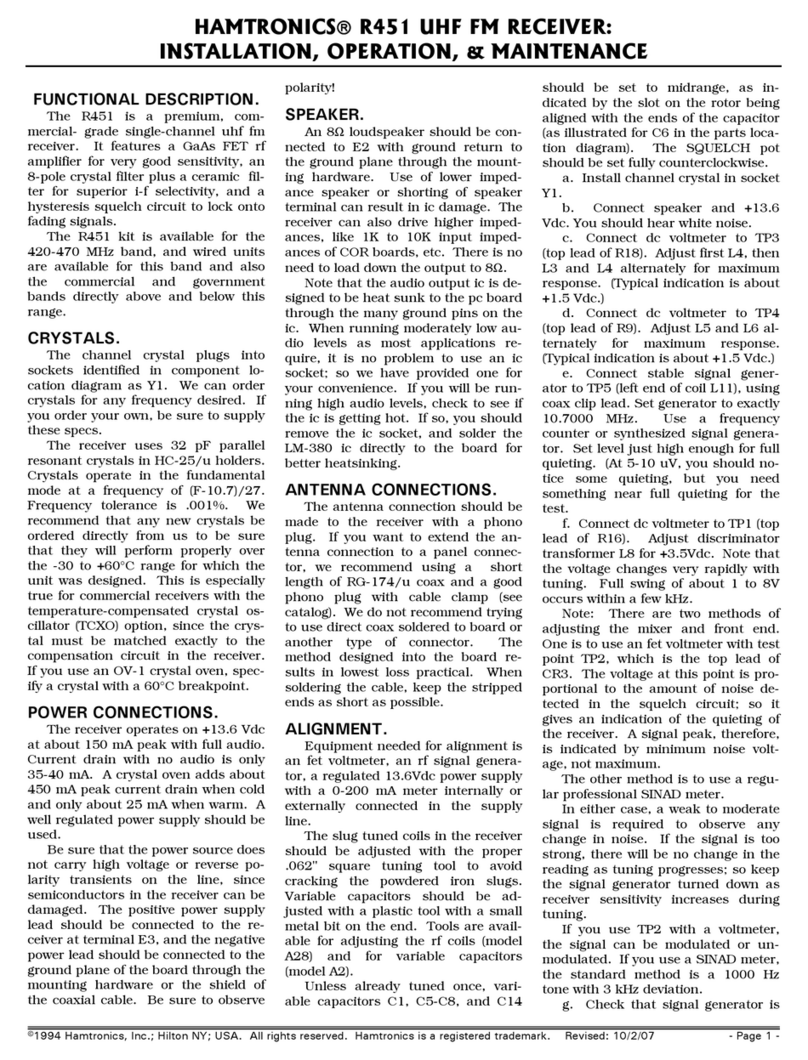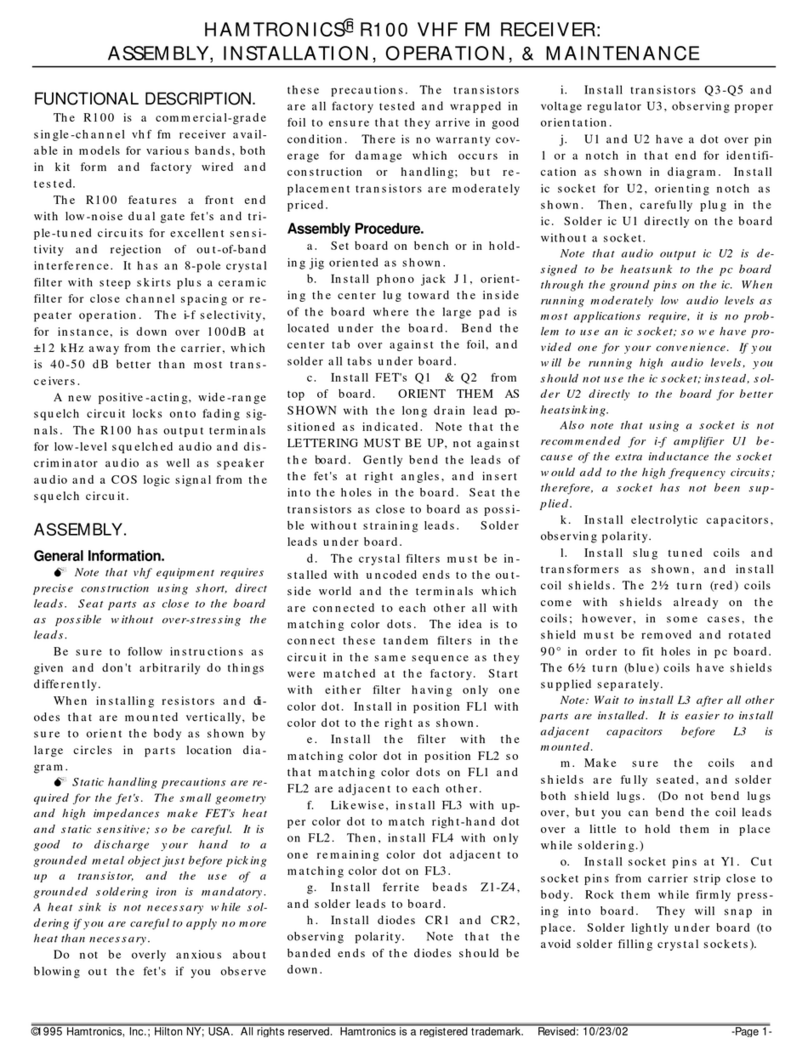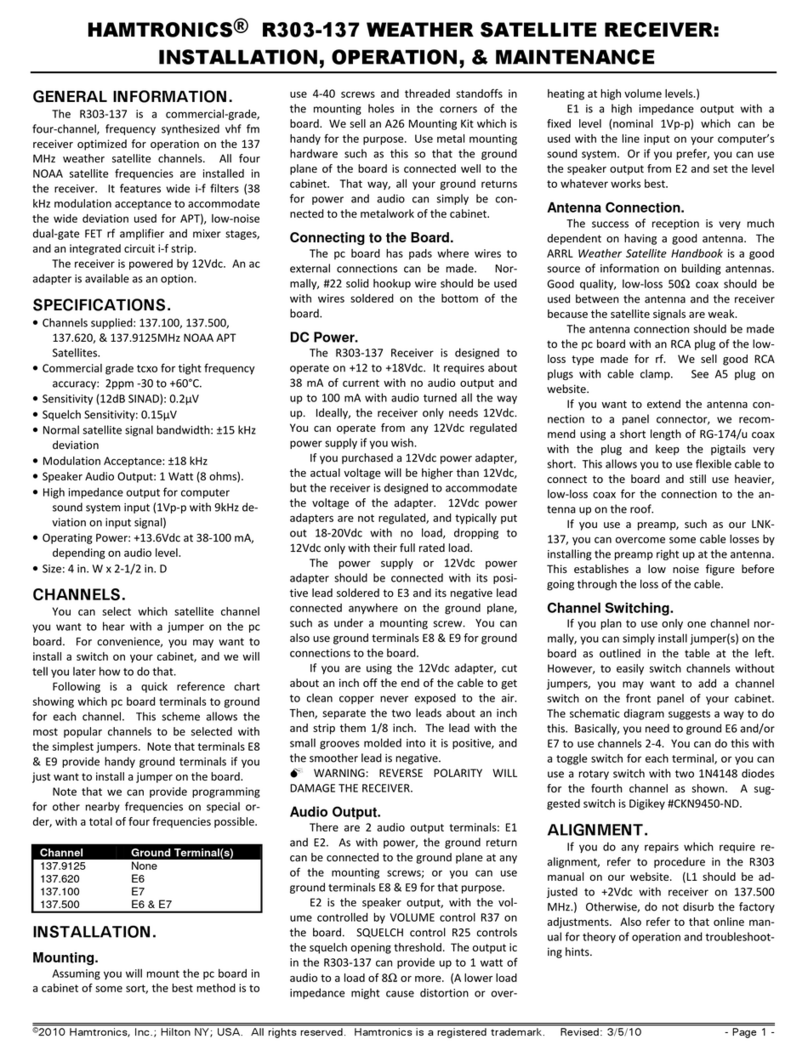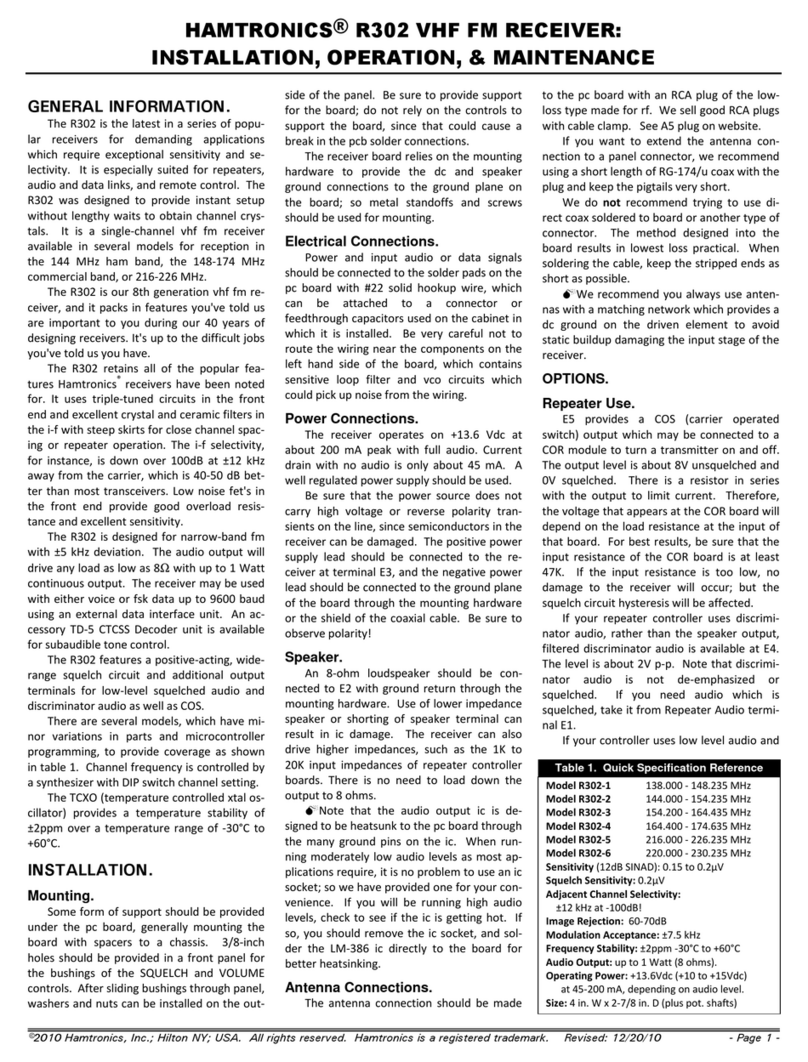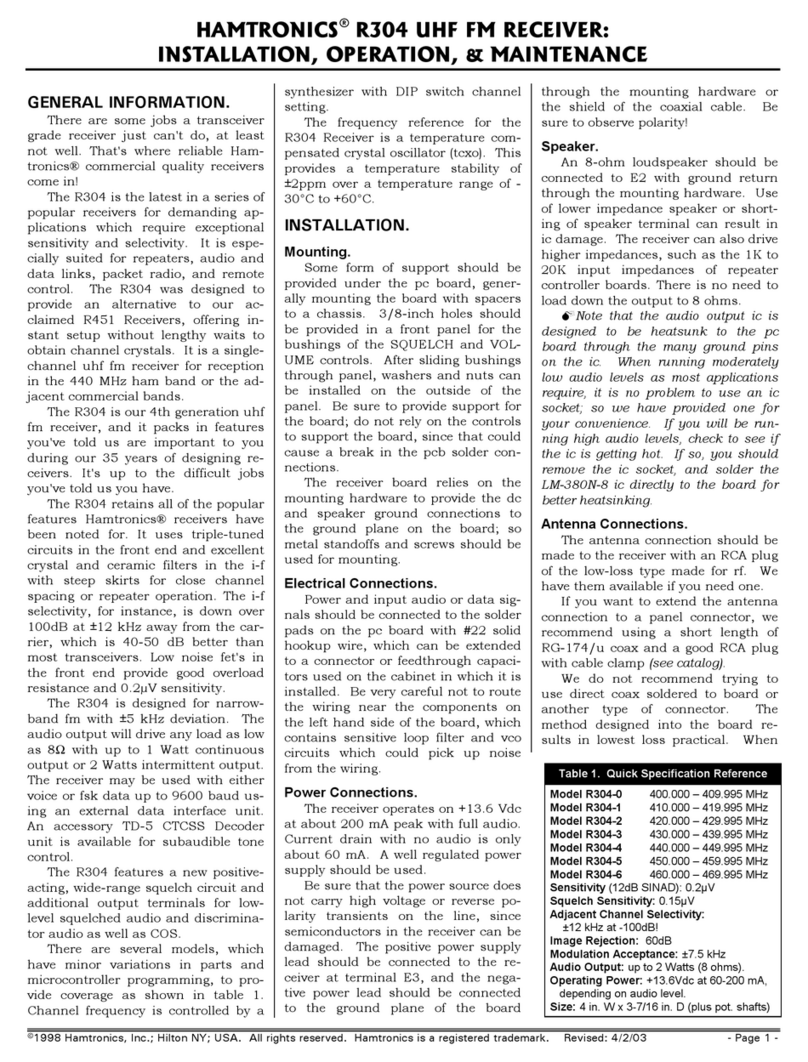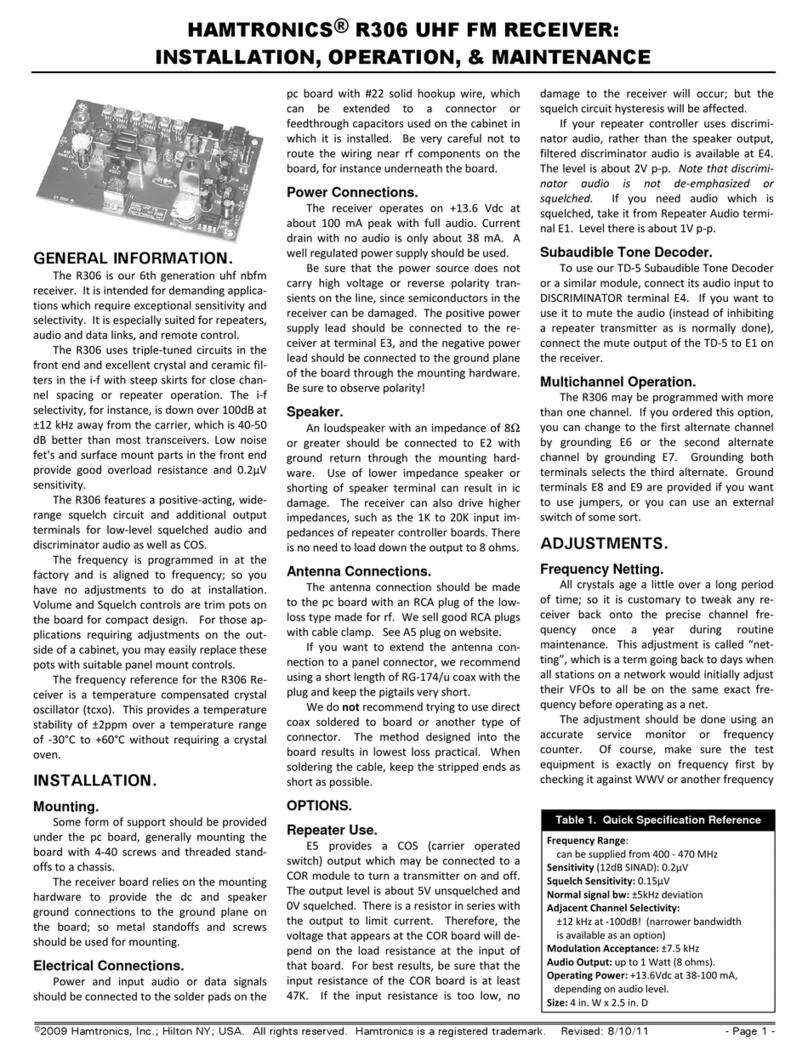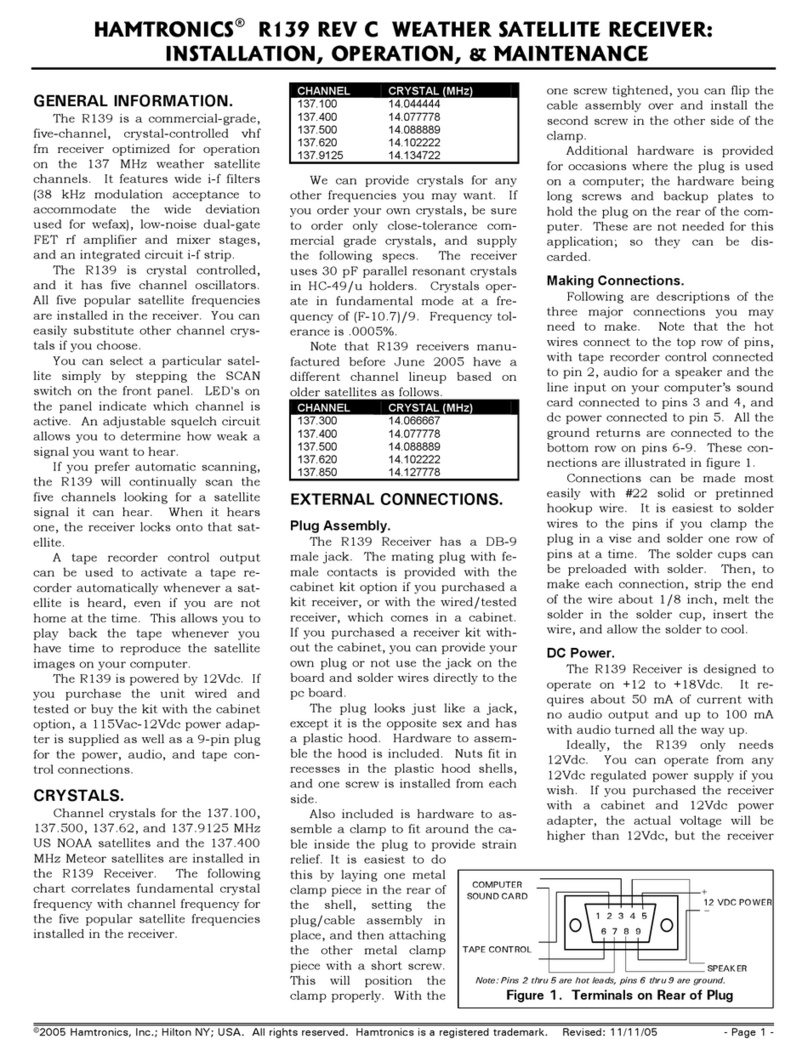
©1998 Hamtronics, Inc.; Hilton NY; USA. All ri
hts reserved. Hamtronics is a re
istered trademark. Revised: 12/11/02 - Pa
e 2 -
Antenna Connections.
The antenna connection should be
made to the receiver with an RCA plug
of the low-loss type made for rf. We
have them available if you need one.
If you want to extend the antenna
connection to a panel connector, we
recommend using a short length of
RG-174/u coax and a good RCA plug
with cable clamp (see catalog).
We do not recommend trying to
use direct coax soldered to board or
another type of connector. The
method designed into the board re-
sults in lowest loss practical. When
soldering the cable, keep the stripped
ends as short as possible.
0We recommend you always use
antennas with a matching network
which provides a dc ground on the
driven element. This reduces chances
of static buildup damaging the input
stage of the receiver as well as provid-
ing safety for the building and other
equipment.
OPTIONS.
Repeater Use.
E5 provides a COS (carrier oper-
ated switch) output which may be
connected to a COR module to turn a
transmitter on and off. The output
level is about 8V unsquelched and 0V
squelched. There is a resistor in se-
ries with the output to limit current.
Therefore, the voltage that appears at
the COR board will depend on the
load resistance at the input of that
board. For best results, be sure that
the input resistance of the COR board
is at least 47K. If the input resistance
is too low, no damage to the receiver
will occur; but the squelch circuit hys-
teresis will be affected.
If your repeater controller uses
discriminator audio, rather than the
speaker output, filtered discriminator
audio is available at E4. The level is
about 2V p-p. Note that discriminator
audio is not de-emphasized or
squelched. If you need audio which is
squelched, take it from Repeater Au-
dio terminal E1.
If your controller uses low level
audio and has a high input imped-
ance (20K or higher), squelched audio
can be obtained from E1 independent
of the VOLUME control.
Discriminator Meter.
If you wish to use a discriminator
meter and you are handy in designing
with op-amps, you can run a sample
of the dc voltage at DISCRIMINATOR
output terminal E4 to one input of an
op-amp and tie the other input to a
voltage divider pot set to provide a ref-
erence voltage of about +3.3Vdc.
S-Meter.
There is no s-meter function, as
such, available in i-f amplifier ic's
made for professional receivers; how-
ever, a signal strength indication is
available at test point TP-5. This volt-
age is a function of the noise level de-
tected in the squelch circuit. It also
varies with SQUELCH control setting.
With the SQUELCH set to where the
squelch just closes, the dc voltage at
TP-5 is about -0.5V with no signal
and +0.75 with full quieting signal.
You can tap off this test point with a
high-impedance circuit, such as an
op-amp, to drive a meter or a comput-
erized repeater controller.
Subaudible Tone Decoder.
To use our TD-5 Subaudible Tone
Decoder or a similar module, connect
its audio input to DISCRIMINATOR ter-
minal E4. If you want to use it to
mute the audio (instead of inhibiting a
repeater transmitter as is normally
done), connect the mute output of the
TD-5 to E1 on the receiver.
ADJUSTMENTS.
Frequency Netting.
All crystals age a little over a long
period of time; so it is customary to
tweak any receiver back onto the pre-
cise channel frequency once a year
during routine maintenance. This ad-
justment is called “netting”, which is a
term going back to days when all sta-
tions on a network would initially ad-
just their VFOs to all be on the same
exact frequency before operating as a
net.
Because modern solid state
equipment doesn’t require much rou-
tine maintenance, many receivers
don’t get their oscillators tweaked as a
matter of routine any more, but they
should.
The adjustment should be done
using an accurate service monitor or
frequency counter. Of course, make
sure the test equipment is exactly on
frequency first by checking it against
WWV or another frequency standard.
The channel frequency is trimmed
precisely on frequency with a small
variable capacitor, which is accessible
through a hole in the top of the shield
can on the TCXO. The proper tool is a
plastic wand with a small metal bit in
the end. (See A2 Alignment Tool in
our catalog.)
To perform this adjustment, it is
first necessary to verify that the dis-
criminator is properly adjusted. Do
this by connecting a dc voltmeter to
TP6. Connect a signal generator set
for 10.700 MHz to TP4, and set the
level for a relatively strong signal so
there is very little white noise. Adjust
discriminator coil T2 for 3.3Vdc.
Then, reconnect the signal generator
to antenna connector J1, and set it for
the precise channel frequency. You
can also use a strong signal on the air
if you are sure it is right on frequency.
Adjust the TCXO capacitor for 3.3Vdc
(to match the voltage obtained with
the 10.700 MHz signal).
Setting Channel Frequency.
The channel frequency is deter-
mined by frequency synthesizer cir-
cuits, which use a dip switch in
conjunction with programming in a
microcontroller to set the channel.
The microcontroller reads the dip
switch information and does mathe-
matics, applying serial data to the
synthesizer ic whenever power is ap-
plied. Following is a discussion of
how to set the dip switch to the de-
sired channel frequency.
☞
☞☞
☞NOTE: If the frequency is
changed more than about 1 MHz, a
complete alignment of the receiver
should be performed, as described in
later text. Optimum operation only oc-
curs if the synthesizer is adjusted to
match the frequency switch setting and
all the tuned amplifier circuits are
peaked for the desired frequency.
To determine what channel fre-
quency to use, the microcontroller
adds the frequency information from
the dip switch to a “base” frequency
stored in eprom used for microcontrol-
ler programming. Each model of the
R301 Receiver has a particular base
frequency. For example, the R301-2
has a base frequency of 144.000 MHz,
as shown in Table 1.
Dip switch settings are binary,
which means each switch section has
a different weighting, twice as great as
the next lower section. Sections have
weights such as 5 kHz, 10 kHz, etc.,
all the way up to 2.56 MHz. (See Ta-
ble 2 or the schematic diagram for
switch values.) For very large incre-
ments, there is even a jumper which
can be added to the board between E6
and E7 for a 5.12 MHz increment, al-
though this is rarely used.
The system sounds cumbersome,
but it really is fairly simple, and you
don’t need to do this frequently. A
